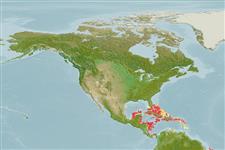Malacostraca |
Amphipoda |
Ampithoidae
Environment: milieu / climate zone / εύρος βάθους / distribution range
Οικολογία
; εύρος βάθους 1 - 27 m (Αναφ. 86733). Tropical
Western Central Atlantic: Belize and Bahamas.
Length at first maturity / Μέγεθος / Weight / Age
Γεννητική Ωρίμανση: Lm ? range ? - ? cm
Minimum depth from Ref. 87027. Only herbivorous amphipod known to feed only on and creates a domicile out of a few closely related seaweeds which produce dictyol-class diterpenes, a compund that prevents it from being eaten by reef fishes (Ref. 86733). Inhabits a portable domicile that is constructed from a rare alga, Dictyota bartayresii (Ref. 86733).
Life cycle and mating behavior
Γεννητική Ωρίμανση | Αναπαραγωγή | Γεννοβολία | Eggs | Γονιμότητα | Larvae
Members of the order Amphipoda are gonochoric and sexually dimoprhic (males larger than females). Mating behavior: Males locate potential partners with the aid of their antenna to detect the pheromones released by the females; the male then rides or carries the female until the latter is ready to molt. When the female is ready, the male pushes the sperm into the marsupium and releases the female afterwards. A few hours later, the female releases her eggs into the marsupium for fertilization. Life cycle: Eggs are brooded in the marsupium. Eggs hatch into juveniles and remain in the marsupium for a few days. Each species undergo 20 molts at most, i.e., 1-year long life cycle.
Hay, M.E., J.E. Duffy and W. Fenical 1990 Host-plant specialization decreases predation on a marine amphipod: an herbivore in plant's clothing. Ecology 71(2):733-743. (Αναφ. 86733)
IUCN Red List Status
(Αναφ. 130435: Version 2025-1)
CITES status (Αναφ. 108899)
Not Evaluated
Not Evaluated
Threat to humans
Harmless
Human uses
| FishSource |
Εργαλεία
Περισσότερες πληροφορίες
Population dynamicsΑύξηση
Max. ages / sizes
Length-weight rel.
Length-length rel.
Length-frequencies
Mass conversion
Αφθονία
Life cycleΑναπαραγωγήΓεννητική ΩρίμανσηΓονιμότηταΓεννοβολίαEggsEgg developmentLarvae PhysiologyΚατανάλωση οξυγόνου
Human RelatedStamps, coins, misc.
Διαδικτυακές πηγές
Estimates based on models
Preferred temperature
(Ref.
115969): 26.7 - 28.2, mean 27.7 (based on 366 cells).
